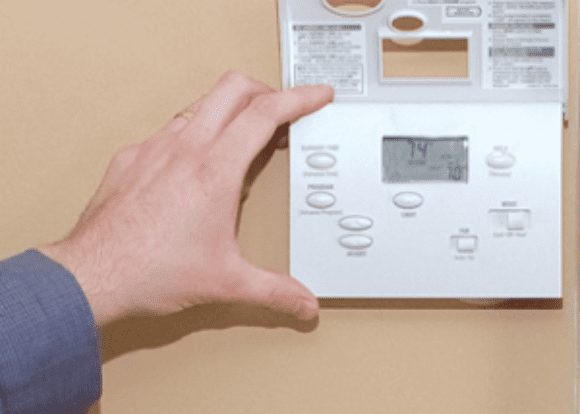A thermostat may only be a small device. But it’s one that no home can do without. It activates your air conditioner or boiler, to help you effectively regulate the temperature in your home. The thermostat does this by turning on these appliances at pre-set times of the day. It can also turn them off when the temperature reaches a certain level. This can help you reduce your energy usage, which in turn can reduce your utility bills each month. However, this is only possible if you know how to set your thermostat correctly. Unfortunately, many homeowners fail to see the importance of their thermostat and the savings it could give them.
Keeping your home warm or cool can be expensive and bad for the environment. But not using your heating or cooling systems can make your home uncomfortable during certain times of the year. This can leave you in a difficult predicament. However, if you know how and when to set your thermostat, none of these issues need to be a concern. Take a look at this useful guide to find out how to save energy by programming your thermostat perfectly.
Read the Manual
Before you do anything else, you need to make sure you read the manual for your thermostat. There are many different models of thermostat available to buy on the market. Even though they all do the same job, the way they are programmed can vary widely. Not knowing how to use its functions correctly could mean that your thermostat turns on at the wrong times and at the wrong temperature. This can lead to an increase not only to your energy usage but to your utility bills too. The easiest way of preventing this from happening is by thoroughly reading through the manual that came with your thermostat. You might also be able to find these manuals online if you’ve misplaced it.
Use the manual to help you learn more about each function and setting on your thermostat device. This is particularly important if your thermostat controls both your heating and cooling appliances. The last thing you want is to accidentally turn on your boiler when you really wanted your air conditioner. This can make your home and your family very uncomfortable. So make sure you know exactly how to turn on each function before you start programming your thermostat. If your thermostat can be controlled by your phone or tablet using an app, also make sure you know how to use this properly too.
Track Your Schedule
Tracking your schedule might seem like an odd thing to suggest in a guide regarding how to set a thermostat. But it can be an extremely beneficial thing to do. Having your air conditioner or boiler turned on when you and your family aren’t at home can be wasteful. It uses energy that nobody is benefiting from, while also raising your utility bills. If this continues over weeks and months, you’re almost guaranteed to see an increase in how much you need to pay. This is understandably something you want to avoid, particularly if your budget is tight.
The best way to prevent this from happening is knowing when you aren’t at home during the day. So start keeping track of when you and your family are out of the house. This will give you a good indication of when your thermostat should be set to turn off your heating or cooling appliances. You might also want to consider turning it off when you are asleep for even further savings.
It also helps you determine the best times for them to be activated and at what temperature. This is likely to be during the mornings and evenings when everyone returns home from work and school. Knowing this information can help you set your thermostat more accurately while also reducing your energy bills.
Choose the Right Temperature
Choosing the right temperature is something that many homeowners find difficult. It’s no secret that we all deal with hot and cold weather in different ways. One family might be able to adapt to cooler temperatures better than another. So it can be challenging to know what temperature to set your thermostat to. You want to use your heating and cooling appliances to maintain a comfortable temperature. But you also want to ensure you save money while you are doing it too. This can make choosing the right temperature even more confusing.
Getting it wrong could cause a number of issues. A temperature that is too high will naturally raise your energy bills because your appliances have to work harder. It can also make the heat in your home unbearable. However, keeping them too low can also cause problems. You won’t feel the benefits of your heating or cooling appliance which can make your home too cold or humid. This can prevent it from being the welcoming place that your home ought to be. So when setting your thermostat, you need to ensure that you are smart and realistic about the temperature you choose.
When setting the thermostat for your air conditioner, choose a temperature that is as high as possible. But try to keep yours and your family’s comfort levels in mind. If you’re unsure what temperature to set your thermostat to, 78 degrees Fahrenheit is often considered ideal. So try this temperature to see how it makes your home feel and adjust if needs be. If you find these high temperatures difficult to get used to, work up to them gradually rather than all at once. You can do this by turning up the temperature by one degree each day. This can help you and your air conditioning system adjust with ease to the higher temperatures.
Choosing the highest temperature you can all stand is extremely beneficial if you intend to save energy and money. When the temperature on your thermostat is as close to the temperature outside, it doesn’t have to work as hard. This lowers your energy bills by saving more energy. It can also prevent faults caused by overworked air conditioning units.
When setting the thermostat for a boiler or furnace, the opposite train of thought is needed. You need to reduce the temperature on your thermostat rather than increase it. This is so you can maximize savings by conserving as much energy as possible. 68 degrees Fahrenheit is recommended, particularly during times when you and your family are at home. Going over this temperature could add a considerable amount to your energy bills each year. So do your best not to raise the settings any higher. Again, it might take some time to get used to this change in temperature, depending on your family’s comfort levels. So if you’re used to having your heating to a degree that is higher than 68, reduce it gradually by one degree each day. Your body will soon get used to the new temperature within your home.
When your heating is not in use, you can turn the temperature of your thermostat down even further. Reducing it by 10 or 15 degrees when you are asleep or out could give you more substantial savings each year. But always keep your family’s comfort in mind before doing so.
Hopefully, you should now have a much clearer idea of how to set your thermostat. Knowing how to set it correctly can make your home a more comfortable place to spend time. It can also give you substantial savings on your energy bills each year. This is understandably a big bonus that all homeowners should be taking advantage of. So instead of overlooking your thermostat, start using it more effectively to benefit your home and your wallet.

